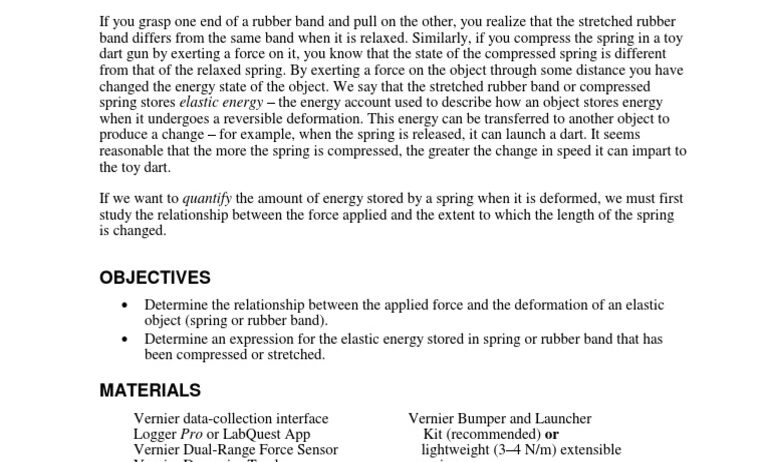Elastic energy conservation is an intriguing concept in both machinery and sports, captivating engineers and athletes alike. The fundamental principle of conserving elastic energy is rooted in the ability of certain materials to deform and then return to their original shape. This phenomenon is not just a scientific curiosity; it has profound implications for efficiency in machines and performance in athletic pursuits.
At its core, elastic energy conservation relies on the interplay between potential energy and kinetic energy. When a material or object is deformed elastically—such as stretching a rubber band or compressing a spring—energy is stored in the system. This stored elastic energy can be transformed back into kinetic energy when the object resumes its original shape, making the system not only efficient but also effective. In this exploration, we delve into ways to harness and conserve elastic energy across various domains.
Machines, a collective term for devices designed to perform work, can significantly benefit from the conservation of elastic energy. In modern engineering, incorporating materials with high elastic potential can enhance the efficiency of machines. For instance, consider the design of automotive suspensions, where springs play a vital role. These springs store elastic energy when compressed during a drive over rough terrain, and then release that energy to provide a smoother ride. Utilizing improved materials such as advanced polymers or composites leads to greater energy retention and subsequently, less fuel consumption.
Moreover, engineers are continually investigating ways to reduce energy loss through hysteresis—a phenomenon where energy is lost during the deformation and recovery phases due to internal friction within the material. By optimizing the choice of material and the geometry of mechanical components, manufacturers can enhance the conservation of elastic energy, ultimately leading to machinery that is more sustainable and cost-effective.
In sports, the principle of conserving elastic energy manifests dramatically, especially in disciplines such as athletics, gymnastics, and certain ball sports. Athletes adeptly utilize this stored energy to enhance their performance. A prime example is the high jump where athletes bend their knees and compress their ankle joints before launching themselves upwards. This action compresses the elastic energy within the tendons and muscles, which is then explosively released, giving the athlete additional height for the jump.
Likewise, in sports involving running mechanics, the conservation of elastic energy is crucial. The leg’s tendons and muscles act like springs; when an athlete lands, they compress these structures, storing energy, which is recycled in the next phase of the stride. This concept is vital in training methodologies. Coaches emphasize techniques that maximize this energy return, instructing athletes on how to optimize their form to minimize energy loss, thereby improving efficiency and performance.
Furthermore, the design of sports equipment also plays a significant role in conserving elastic energy. Consider modern footwear, which has seen remarkable innovations in cushioning technology. Shoes engineered with advanced foam materials can absorb and then return elastic energy more efficiently than traditional designs. This not only provides better support for the athlete but also aids in performance by enhancing energy return with each stride. The synergy between equipment design and athletic performance underscores the necessity for continual advancements in material science.
However, while the conversation around conserving elastic energy often emphasizes technology and performance, it is essential to recognize the environmental impact as well. Efficiency derived from the optimal use of elastic energy not only reduces energy consumption within machines but also contributes to sustainability in sports equipment manufacturing. By fostering energy-efficient practices, both industries can mitigate their environmental footprints.
From a broader perspective, conservation strategies also extend to training practices for athletes. Emphasizing the biomechanics of movement and the role of elastic energy can lead to tailored training regimens that focus on strength, flexibility, and technique, ultimately fostering a new generation of athletes who are not only skilled but also mindful of efficient energy use.
In conclusion, the conservation of elastic energy in machines and sports represents a fascinating intersection of science, engineering, and human endeavor. By understanding the mechanics of elastic energy, practitioners in both fields can enhance performance while contributing to broader sustainability efforts. As technology advances and our understanding deepens, the potential to innovate and improve energy efficiency grows. Thus, while elastic energy conservation serves as a fundamental principle in machinery and athletic performance, it also stands as a cornerstone for the future of sustainable practices within these realms.
Harnessing this insight is imperative, not only for enhancing operational efficiencies and athletic prowess but also for cultivating a deeper appreciation of the natural world’s resources. Only then can we truly marvel at the complex harmony between energy, movement, and sustainability.




